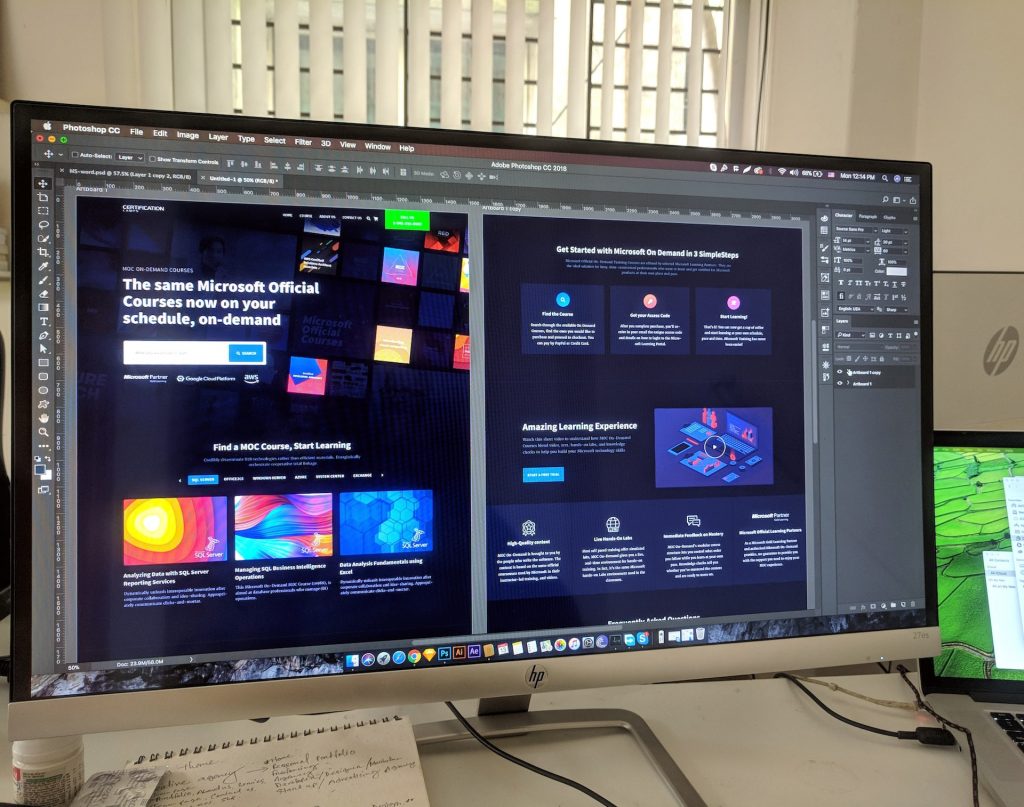
UX Vs UI Design: What’s The Difference? [2023 Guide]
Jerry Wallis
12 min read

UX vs UI is an often-debated topic in the web and mobile design world. From a high-level viewpoint, UX (user experience) is focused on the customer journey, considering the product’s ease of use, usability and usefulness. In contrast, UI (user interface) primarily refers to how the product looks and feels from an aesthetic standpoint.
When it comes to web design, you may have heard people throwing around the terms “UX” and “UI” interchangeably in conversations. Are they similar? Or are they as different as they sound? Believe it or not, there’s a significant difference between UX design and UI design — equally essential aspects of creating a phenomenal digital experience.
With the two falling under a related umbrella of web and software design, it can be easy to confuse which one does what. Both UX and UI employ various techniques and technologies for crafting a compelling experience for users as they explore a digital product. Yet, understanding their differences is essential in creating a successful website or app.
If you want increased familiarity with these terms, this blog post will help massively. We will delve into what makes them unique and why each element contributes to an all-around engaging user experience for your visitors.
We’ll also unpack each concept in greater detail, discuss how UX and UI interact when designing and prototyping mockups of intended user experiences, and distinguish which elements fall into the scope of each field—all while highlighting why these distinctions matter! So buckle up for an exciting ride through UX vs UI Design!
What Is UX Design & Why Is It Important? 🏃🏼♂️
UX Design, which stands for User Experience Design, encompasses creating a seamless customer journey through all stages of user interaction by designing a user-friendly product with seamless navigation and helpful features. The fundamental concept of UX revolves around how the user engages and interacts with a website or a digital product. In a nutshell, you are designing to improve this interactive experience for your user.

UX designers focus on flow, structure, and elements like navigation and content that make a conscious website navigation experience easier and more enjoyable. In addition, they prioritise creating intuitive and easy-to-use experiences by empathising with potential users and understanding their pain points.
In a sense, UX can be considered the product’s overall design despite not directly dealing with the aesthetic elements, considering how it emphasises a product’s intuitiveness, the feelings it conveys, and other considerations that affect the user’s engagement with the product. Importantly, UX design creates a valuable framework for users that should effectively solve their needs and wants by developing a strategy for design ideas.
Finally, it’s important to note that UX design is just a tiny part of the overarching user experience picture. UX design works hand-in-hand with other sub-modalities of UX, such as UX research, UX strategy, UX writing, and UX testing.
What Is UI Design & What Role Does It Play? 🎨
UI stands for user interface, which is all about visual design elements such as colours, shapes, and images and how they work together to provoke an emotional response from the viewer. But what is a user interface? A user interface is the point of interaction between the user and a digital product—like the touchscreen on your smartphone or the touchpad you use to select what coffee you want from the coffee machine.
As such, UI focuses on designing a beautiful interface that eases user engagement, is visually appealing, and makes completing tasks more manageable for the end user.

In contrast to UX designers, UI designers focus mainly on a digital product’s aesthetic side. They prioritise their efforts towards improving the visual interface to make users want to engage with a website or application. To summarise, UI designers look at pixels of what fits the UX strategy, from colours to icons to typography and develop engaging visuals within parameters, so users have great experiences using a website or app.
UI focuses more literally on the visual aspects of the product-the branding guidelines incorporated, buttons presented to take action on tasks, and other elements that control how users interact with a product.
Concerning websites and apps, UI design considers the product’s look, feel, and interactivity. Therefore, it prioritises improving the intuitiveness of a product’s user interface by considering every visual and interactive element the user might encounter and making optimisations to enrich such interactions.
UX vs UI Design – The Key Differences ⚖️
Where do UX and UI differ from one another? How do their ideas contrast? What are some of their key distinctions? Let’s dive in and explore the differences between these two competing ideologies.
💡 Fundamental Concept
The core idea behind UX revolves around the user’s journey with a product and optimising that process by eliminating any problems they may encounter.
On the other hand, UI heavily emphasises a product’s look and function by improving the visual experience. In a way, UI is almost like the cherry on top of a cake, as it’s only a piece of the overall user journey.
🎯 Focus Elements
UX design is concerned with the overarching conceptual elements of a digital product – feel, ease of use, usability, usefulness, accessibility, etc. Consequently, great UX designers have in-depth user research, strategising, and interaction design skills.
UI design lends itself to more tangible and quantifiable components such as visual aesthetics, branding, interactivity, etc. This is why UI designers tend to have skill sets relating to brand and graphic design and motion design.
🎭 Role In Design
UI is almost like the framework or a guide that gets us to our destination, while UX is the delightful experience we have upon arrival. Here’s an interesting analogy: UI is the journey, but UX provides the thrills.
It’s like having a GPS to our destination and getting that victorious feeling when we finally reach it! What made your journey successful? The intuitiveness of the application and the interface merely facilitated its use.
🚘 Design Approach
By taking a user-centred approach, UX design looks beyond the limits of traditional UI. Instead, it delves deeper into understanding how best to make users’ journeys through products as smooth and enjoyable – or, indeed, as helpful as possible.
In essence, UI embraces constraints while, at the same time, UX challenges them, making for successful customer experiences that both appeal to customers and meet business needs as well.
How Do UX and UI Work Together? 🤝
UX and UI are essential components of creating successful web or mobile experiences for your customers. While UX plays a more significant part in establishing long-term customer loyalty since it establishes an enjoyable user experience from the get-go, the role of UI cannot be underestimated either.
Despite their differences, UX and UI are essential when creating any digital product to make your users feel intuitively guided through the experience. In addition, both UX and UI depend heavily on one another when designing a successful software or website – UX sets up the structure of a project, while UI decks it out with designs and visuals.

While different, you blend these two design concepts together to create a holistic product for your customers. For instance, you must focus your UX efforts on igniting a user’s positive feelings when interacting with an interface by smartly incorporating the visual and functional elements.
The visual elements in your UI arsenal, such as menus, buttons, typography, colours, and more, must complement the functional design and provide a pleasant user experience.
To keep things simple, UX and UI go hand in hand when designing a great product. UX helps create a product’s core functionality, while UI ensures it looks its best.
UX vs UI – Which Is More In Demand? 📈
The demand for UX and UI professionals has been growing steadily over the past few years. However, UX has had a slight edge in recent demand growth as companies realise the importance of creating an engaging user experience when developing their applications.
UX design’s increasing demand can also be attributed to rapidly changing technology requiring UX considerations for successful user engagement.
UX design also provides valuable insights regarding customers’ needs and preferences, allowing you to tailor the product to those preferences.
With customised and catered customer experiences a massive part of today’s digital consumer preferences, the popularity and demand of UX design are likely to continue growing.
Thus, UX design is the perfect bridge between business goals and user needs, making it more integral to a business’s marketing and customer experience efforts than UI design.
That said, UI designers remain an invaluable asset for any UX effort, ensuring users get an aesthetically pleasing experience that functions well and provides them with what they need.
UX and UI remain essential elements to any successful app or website, meaning that both UX and UI will continue to be in high demand.
UX vs UI Designer – Which Is A Better Career For Your Future? 👨💻
This fascinating debate has been ongoing for years and creates a fundamental divide in the design world. But which is the right career option for a design enthusiast?
🤔 What Does A Career In UX Design Involve?
UX designers believe that understanding user needs and turning those needs into practical and usable products outweigh traditional design aesthetics. Their specialty in creating experiences that facilitate interaction between users and the interface they’re interacting with is considered more complex and technically sophisticated.
UX relies on data to research, analyse and understand users to design a seamless journey instead of visual elements like buttons and images that drive user adoption.
UX designers typically use tools such as Adobe XD and Figma for creating low and high-fidelity wireframes and prototypes.
🖥️ What Do UI Designers Do?
UI designers have their own school of thought and mainly concern themselves with how the end product looks visually. As a result, you often find them designing mockups to determine which style fits best for a particular product.
UI designers use graphic and interface design tools, including Adobe Creative tools such as Photoshop, Illustrator, Sketch, and more.
👣 UX vs UI Designer – Which Path To Pursue?
Considering UX and UI’s integral roles in providing end-users with meaningful experiences, it is an important question – which one is better suited as a career path?
UX and UI offer enticing salary packages and job prospects. However, UX is usually considered a broader field than UI, with elements of research, design strategy, wireframing and psychology involved.
For professionals who enjoy tackling challenges that require creativity through collaboration, UX may be the better choice for their future. UX is often more analytical. UX designers typically focus on problem-solving and creating innovative digital experiences. In contrast, UI designers have an eye for visual detail and creativity. UI looks at the aesthetically pleasing elements of a project.
Ultimately, it depends on your skill set and what you enjoy doing; UX design requires analytical thinking, whereas UI design requires more creative thinking.
UX and UI offer tremendous growth potential for aspiring designers regardless of your choice. In addition, both present exciting opportunities in the ever-expanding world of technology, so it’s worth considering both when deciding.
How Do UI & UX Influence Customer Experience (CX)? 🧲
UI and UX design are integral parts of CX because they determine the interaction between a product or service and its user. They help guide customers through processes, ensure ease of access, and provide an overall enjoyable experience for the user.
Good UI/UX design can make otherwise complex tasks more manageable by breaking them down into smaller components and tailoring them to customers’ needs. With a clear CX based on reliable UI/UX design, companies substantially increase their chances of retaining customers while building loyalty, trust, and long-term relationships with users.

Understanding and improving User Interface (UI) and User Experience (UX) can significantly impact the overall customer experience. CX directly relates to how customers perceive the products or services they interact with, and UI/UX are critical components of this relationship.
From the moment a customer arrives at a website’s home page, their CX journey is affected by aspects like navigation tools, visual design tools, sound and animation components, etc. These UX and UI elements must be designed with CX in mind to lead the customer towards their goal as effortlessly as possible.
UI/UX also affects CX because it provides customers with helpful feedback and allows them to interact intelligently with interfaces; things like colour schemes, font selection, words and images can do wonders to create unique CX experiences for customers.
UI and UX are two interrelated aspects of CX which have a powerful effect on how customers interact with a product or service. An interface with good visuals, clean typography, logical navigation, and good colour schemes can produce a more positive CX overall. An excellent CX should also leverage technology whenever appropriate so that customers can easily find what they need quickly and efficiently.
In conclusion, with UI and UX playing an essential role in CX, businesses can optimise their customer experience for tremendous success. Together they create a necessary platform for building great CX for brands of all scales and sizes.
UX vs UI: Final Words 📋
So, what’s the difference between UX and UI design? In summary, UX is about improving user satisfaction by creating a practical and enjoyable experience, while UI focuses on the aesthetics of a product – making it easy on the eyes. But, of course, that’s just the tip of the iceberg, and there’s so much more to it than that.
If you want to learn more about creating beautiful and compelling user experiences, we can help. Our team of experts would be happy to chat with you about your project and see how we can make your website or app shine. All you need to do is book a discovery call with one of our consultants to get started.
We can help you figure out which aspects of your website or software application could improve in terms of usability and visual appeal and help you maximise your customer’s experience with your brand. Thanks for reading!
Topics
Published On
December 15, 2022

